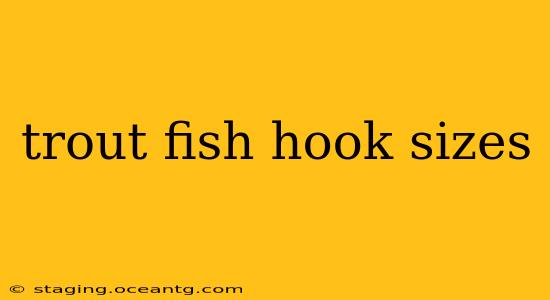Choosing the right hook size for trout fishing is crucial for success. The ideal size depends on several factors, including the species of trout, the size of your bait or lure, and the fishing conditions. This guide will delve into the intricacies of selecting the appropriate trout fishing hook size, helping you land more fish.
What Size Hook Should I Use for Trout?
This is the most frequently asked question, and the answer isn't straightforward. There's no one-size-fits-all answer. Generally, smaller hooks are preferred for smaller trout and lighter tackle, while larger hooks are suitable for larger trout and heavier tackle. However, the type of bait or lure you're using also plays a significant role.
-
For small trout (under 10 inches): Sizes #10, #12, #14, and even smaller are commonly used with small flies, spinners, or live bait.
-
For medium trout (10-14 inches): Sizes #8, #6, and #4 are appropriate choices for a wider variety of lures and baits.
-
For larger trout (over 14 inches): Sizes #2, #1, and even larger hooks may be necessary, especially when using larger lures or bait.
Remember, it's often better to err on the side of using a smaller hook. A smaller hook is less likely to scare off a fish, and the smaller barb will often lead to a quicker and easier release, should you choose to practice catch and release fishing.
What Hook Size for Trout Fishing with Worms?
When fishing with worms for trout, hook size selection depends on the size of the worm and the size of trout you expect to catch. A smaller worm will call for a smaller hook, while a larger worm will require a larger hook.
-
Small Worms: Sizes #10-#8 hooks are ideal for small worms and smaller trout.
-
Medium Worms: Sizes #6-#4 hooks are suitable for medium-sized worms and trout.
-
Large Worms: Sizes #2-#1 hooks can be used with larger worms for bigger trout, though often you'll want to consider cutting the worm into smaller pieces to better match the hook size.
What Hook Size for Trout Fishing with Flies?
Fly fishing for trout demands precision and the right hook size is essential. Fly hook sizes are typically measured in numbers, with smaller numbers indicating larger hooks. The hook size you use will depend on the fly pattern and the size of trout you're targeting.
-
Small Flies (dry flies, nymphs): Sizes #14-#18 and even smaller are common.
-
Medium Flies (wet flies, streamers): Sizes #8-#12 are generally used.
-
Large Flies (streamer flies): Sizes #4-#6 or even larger may be appropriate for larger trout.
What Kind of Hook is Best for Trout?
While hook size is crucial, the type of hook matters as well. Different hook styles are designed for various bait presentations and fishing techniques. Some popular choices for trout fishing include:
-
Barbless Hooks: These hooks are environmentally friendly and easier to remove from the fish, promoting catch and release fishing.
-
Spey Hooks: Designed for swinging flies in rivers, these hooks are durable and reliable.
-
Dry Fly Hooks: These hooks are typically lighter and have a sharper point for better penetration.
-
Nymph Hooks: Slightly heavier than dry fly hooks, these are designed to sink effectively.
The best hook type ultimately depends on your chosen method and the type of bait or lure used.
What Type of Hook for Catch and Release Trout Fishing?
For catch and release trout fishing, barbless hooks are strongly recommended. Barbless hooks make removing the hook from the fish's mouth much easier, causing significantly less damage and increasing the chances of the trout's survival. This contributes to the sustainability of trout populations. They also reduce the risk of injury to the angler.
Remember that this guide provides general recommendations. Experimentation and observation are key to finding the perfect hook size and type for your specific trout fishing situation. Consider the factors discussed and don't be afraid to adapt your approach based on the conditions you encounter on the water. Tight lines!
